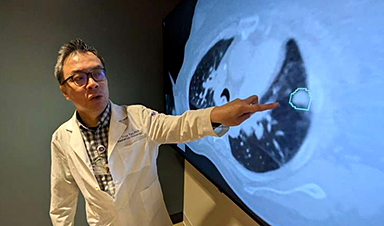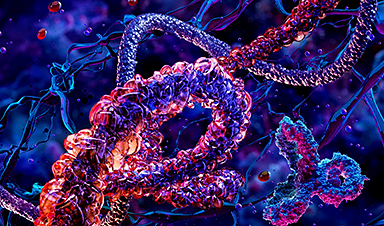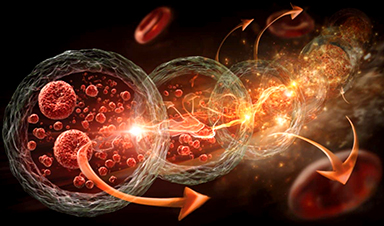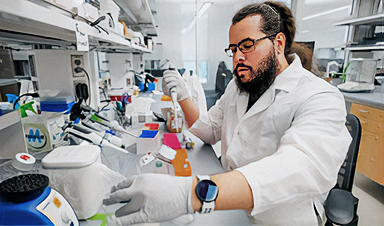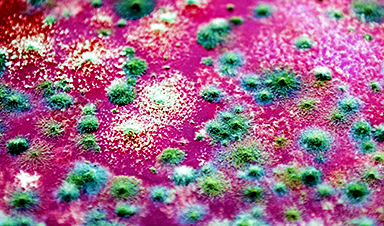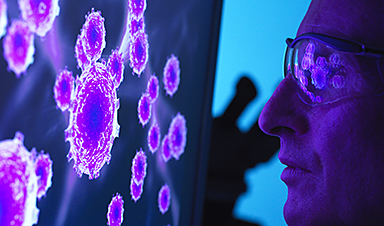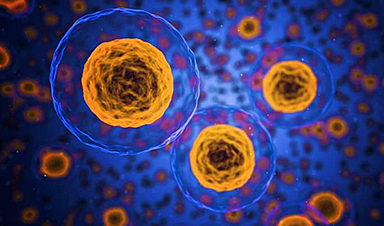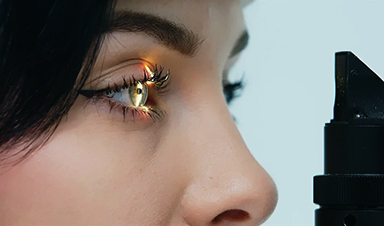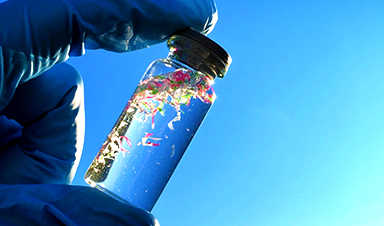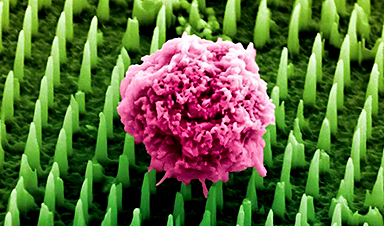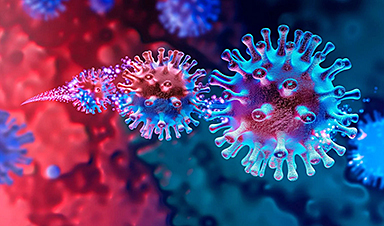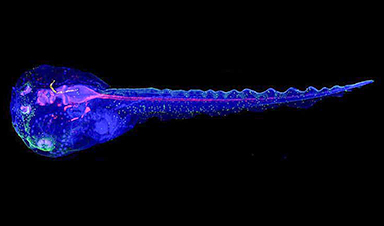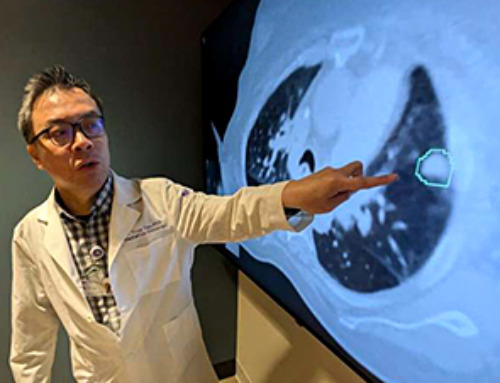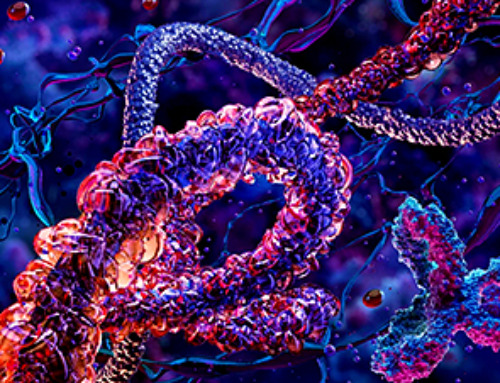| An international research team, led by scientists from the EMPA (Zurich) and the International Iberian Nanotechnology Laboratory, which has researchers from the UPV/EHU, has succeeded in building chains of quantum magnets made of nanographene that capture the essence of one of the core models of quantum magnetism. The team’s results (Nature, “Observation of fractional edge excitations in nanographene spin chains”) have implications for understanding quantum magnetism on the nanoscale and may open the door to building quantum computers. | |
| We are all used to the idea that simple units combine to form more complex structures. So atoms combine to form molecules, which in turn combine to form cells, and cells form tissue, ultimately giving rise to living beings. | |
| In the quantum world, this process may take place in reverse in such a way that the interaction between complex particles results in simpler particles. So, under certain circumstances, the interaction between electrons, indivisible particles with electric charge e, gives rise to the emergence of particles with charge e/3. This phenomenon is known as fractionalization. | |
Quantum magic: fractionalizing spins |
|
| All elementary particles have intrinsic properties such as mass or charge that are intuitive to us, and others such as spin, which can be visualised like a compass. However, unlike normal compasses, which can point in any direction, the spin of quantum systems is quantized, and can only assume a discrete set of values. For example, we say that the spin of an electron is ½ and can only take two values. Particles with spin 1 can take three values. | |
| In the 1980s the British physicist Duncan Haldane built a mathematical model for spin 1 particles in which the fractionalization of the spins took place. So when a one-dimensional chain of indivisible spin 1 particles interacted with their neighbours, they gave rise to the emergence of spin ½ particles on the edges of the chain. | |
| Like the magic trick in which the magician saws a person in half and pulls the two halves apart, the Haldane model allows spins 1 to be fractionalized and separated. It is one of the core models of quantum magnetism, and his work earned him the Nobel Prize in 2016. | |
One-dimensional chains of magnetic molecules assembled from graphene |
|
| Experimental confirmation of this prediction was challenging for various reasons, chief among them being the fact that one-dimensional materials do not exist. Indirect evidence of the phenomenon of spin fractionalization in organometallic materials containing chains of magnetic atoms existed, but direct observation remained elusive. | |
| Now, however, that observation has been made by an international team of researchers, including the Ikerbasque researcher David Jacob of the Department of Polymers and Advanced Materials: Physics, Chemistry and Technology at the UPV/EHU; he has collaborated in this work with the INL, the University of Alicante, the EMPA in Zurich and the University of Dresden. | |
| To accomplish this difficult feat, the researchers combined organic chemistry techniques with ultra-high vacuum surface science in order to synthesise graphene molecules with spin 1 that form unidimensional chains. Using a tunnelling microscope, the team of researchers were able to study, with atomic resolution, the quantum states of the chain adsorbed on a gold surface, compare them with those predicted by the theory, and establish that the system did in fact behave like the Haldane model. | |
| In particular, in chains with a sufficiently high number of magnetic molecules, the researchers found Kondo resonances at the tips of the chain, a phenomenon that occurs when spin ½ particles interact with the electrons in a conductor such as gold. From one-dimensional chains to two-dimensional networks and quantum computers | |
| The researchers say that this work “shows the potential for using nanographenes to form two-dimensional networks of nanomagnets, enabling predictions analogous to Haldane’s to be confirmed, such as, for example, the existence of quantum states that would allow quantum computation to be carried out”. |
News
AI matches doctors in mapping lung tumors for radiation therapy
In radiation therapy, precision can save lives. Oncologists must carefully map the size and location of a tumor before delivering high-dose radiation to destroy cancer cells while sparing healthy tissue. But this process, called [...]
Scientists Finally “See” Key Protein That Controls Inflammation
Researchers used advanced microscopy to uncover important protein structures. For the first time, two important protein structures in the human body are being visualized, thanks in part to cutting-edge technology at the University of [...]
AI tool detects 9 types of dementia from a single brain scan
Mayo Clinic researchers have developed a new artificial intelligence (AI) tool that helps clinicians identify brain activity patterns linked to nine types of dementia, including Alzheimer's disease, using a single, widely available scan—a transformative [...]
Is plastic packaging putting more than just food on your plate?
New research reveals that common food packaging and utensils can shed microscopic plastics into our food, prompting urgent calls for stricter testing and updated regulations to protect public health. Beyond microplastics: The analysis intentionally [...]
Aging Spreads Through the Bloodstream
Summary: New research reveals that aging isn’t just a local cellular process—it can spread throughout the body via the bloodstream. A redox-sensitive protein called ReHMGB1, secreted by senescent cells, was found to trigger aging features [...]
AI and nanomedicine find rare biomarkers for prostrate cancer and atherosclerosis
Imagine a stadium packed with 75,000 fans, all wearing green and white jerseys—except one person in a solid green shirt. Finding that person would be tough. That's how hard it is for scientists to [...]
Are Pesticides Breeding the Next Pandemic? Experts Warn of Fungal Superbugs
Fungicides used in agriculture have been linked to an increase in resistance to antifungal drugs in both humans and animals. Fungal infections are on the rise, and two UC Davis infectious disease experts, Dr. George Thompson [...]
Scientists Crack the 500-Million-Year-Old Code That Controls Your Immune System
A collaborative team from Penn Medicine and Penn Engineering has uncovered the mathematical principles behind a 500-million-year-old protein network that determines whether foreign materials are recognized as friend or foe. How does your body [...]
Team discovers how tiny parts of cells stay organized, new insights for blocking cancer growth
A team of international researchers led by scientists at City of Hope provides the most thorough account yet of an elusive target for cancer treatment. Published in Science Advances, the study suggests a complex signaling [...]
Nanomaterials in Ophthalmology: A Review
Eye diseases are becoming more common. In 2020, over 250 million people had mild vision problems, and 295 million experienced moderate to severe ocular conditions. In response, researchers are turning to nanotechnology and nanomaterials—tools that are transforming [...]
Natural Plant Extract Removes up to 90% of Microplastics From Water
Researchers found that natural polymers derived from okra and fenugreek are highly effective at removing microplastics from water. The same sticky substances that make okra slimy and give fenugreek its gel-like texture could help [...]
Instant coffee may damage your eyes, genetic study finds
A new genetic study shows that just one extra cup of instant coffee a day could significantly increase your risk of developing dry AMD, shedding fresh light on how our daily beverage choices may [...]
Nanoneedle patch offers painless alternative to traditional cancer biopsies
A patch containing tens of millions of microscopic nanoneedles could soon replace traditional biopsies, scientists have found. The patch offers a painless and less invasive alternative for millions of patients worldwide who undergo biopsies [...]
Small antibodies provide broad protection against SARS coronaviruses
Scientists have discovered a unique class of small antibodies that are strongly protective against a wide range of SARS coronaviruses, including SARS-CoV-1 and numerous early and recent SARS-CoV-2 variants. The unique antibodies target an [...]
Controlling This One Molecule Could Halt Alzheimer’s in Its Tracks
New research identifies the immune molecule STING as a driver of brain damage in Alzheimer’s. A new approach to Alzheimer’s disease has led to an exciting discovery that could help stop the devastating cognitive decline [...]
Cyborg tadpoles are helping us learn how brain development starts
How does our brain, which is capable of generating complex thoughts, actions and even self-reflection, grow out of essentially nothing? An experiment in tadpoles, in which an electronic implant was incorporated into a precursor [...]

